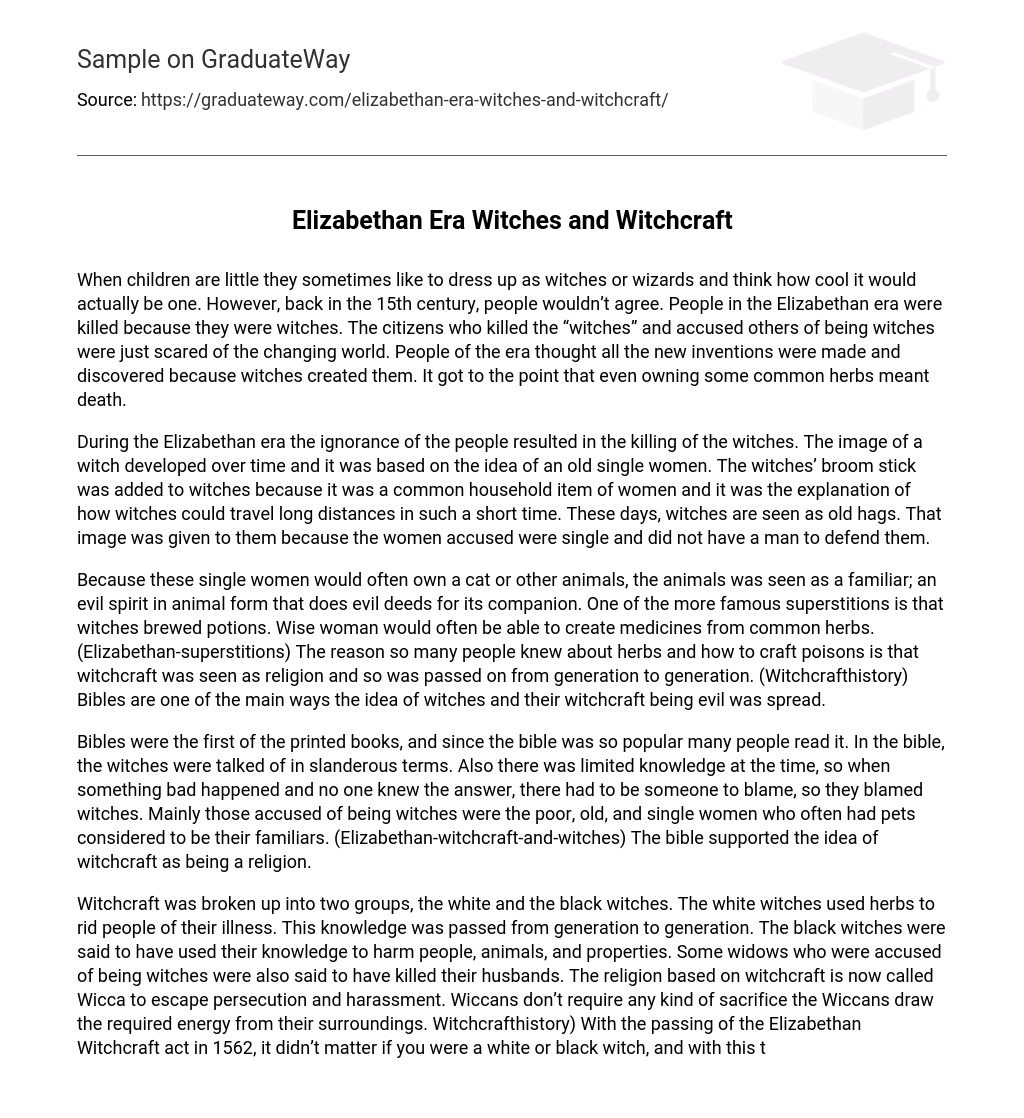During the Elizabethan era in the 15th century, children’s fascination with dressing up as witches or wizards and imagining themselves as such was met with harsh opposition. The individuals accused of being witches faced persecution and even death. Motivated by fear of the rapidly changing world, citizens believed that witches were responsible for creating and discovering new inventions. So much so, that possessing certain everyday herbs could lead to a fatal outcome.
During the Elizabethan era, the ignorance of the people led to the persecution and execution of witches. The stereotype of a witch evolved during this time and centered around the concept of an elderly unmarried woman. The inclusion of a broomstick in depictions of witches originated from the common use of brooms by women in their domestic lives and served as an explanation for their supposed ability to swiftly cover great distances. In contemporary times, witches are typically portrayed as old and unpleasant women. This portrayal stems from the fact that the women accused of witchcraft were often single and lacked male defenders.
In Elizabethan times, single women who owned cats or other animals often considered them as familiars, which were believed to be evil spirits taking animal form and carrying out wicked acts for their companions. One popular superstition during this era was the idea of witches brewing potions. Wise women had the knowledge to create medicinal remedies using common herbs. This understanding of herbs and concocting poisons was so widespread due to witchcraft being regarded as a religion and passed down through generations. Bibles played a significant role in propagating the notion that witches and their practice of witchcraft were inherently malevolent.
The bible, being the first printed book, was widely read and became very popular. It discussed witches in a derogatory manner due to limited knowledge at the time. When something bad occurred, without a clear explanation, witches were often blamed. Typically, those accused of witchcraft were impoverished, elderly, and unmarried women who were believed to have animal companions as familiars. This connection between witches and religion was supported by the bible.
There were two factions in witchcraft: white witches and black witches. White witches used herbs to heal people and passed this knowledge down through generations. Black witches, on the other hand, used their expertise to harm individuals, animals, and properties. Some widows were accused of witchcraft and even killing their husbands. To avoid persecution, the religion associated with witchcraft became known as Wicca. Wiccans don’t require sacrifice; they draw energy from their surroundings.
In 1562, the Elizabethan Witchcraft act was passed which made no distinction between white and black witches and led to witch hunts. The same year saw the implementation of a new witchcraft law that punished lesser acts of witchcraft with pillory punishment – restraining someone’s head and hands between two pieces of wood.
While England didn’t burn witches like the French and Spanish did, burning was still practiced in those countries.
Torture was not permitted as a means of investigation or punishment during the Elizabethan era. The new law did not view sorcery as heresy or a crime against religion, and therefore it was not prosecuted. There are claims that Queen Elizabeth showed interest in astrology, which may explain her leniency towards witches. In Essex, 13% of the trials involved witchcraft, with 63 individuals being accused and 53 found guilty (Elizabethan-witchcraft-and-witches). Despite the absence of torture, many of the accused confessed. During the 15th and 16th centuries, lives did not hold the same value as they do now, so people would often falsely claim they were witches (Elizabethanenglandlife). In total, there were 270 trials against witches, with only 23 involving men. This stemmed from the belief that men wielded ultimate power while women possessed knowledge of witchcraft (Elizabethan-witchcraft-and-witches). Rather than discouraging witch hunts, the Renaissance contributed to their persistence as alchemy, astrology, and magic gained prominence (Sarkis). The fear that witches could employ their powers for evil further fueled the need for witch hunts. Ultimately, it was widespread fear that drove the occurrence of these witch hunts.
People have a tendency to fear and destroy what they do not understand, often resorting to conducting experiments in order to comprehend it. The individuals of the Elizabethan era, although mistreating witches and misinterpreting witchcraft, should not be blamed for the accusations. If the accused were truly innocent and desired to survive, they could have demonstrated their innocence. The ignorance of the general population played a significant role in the deaths of the witches. If everyone possessed even a rudimentary level of knowledge like the present time, this entire event may have been preventable.





